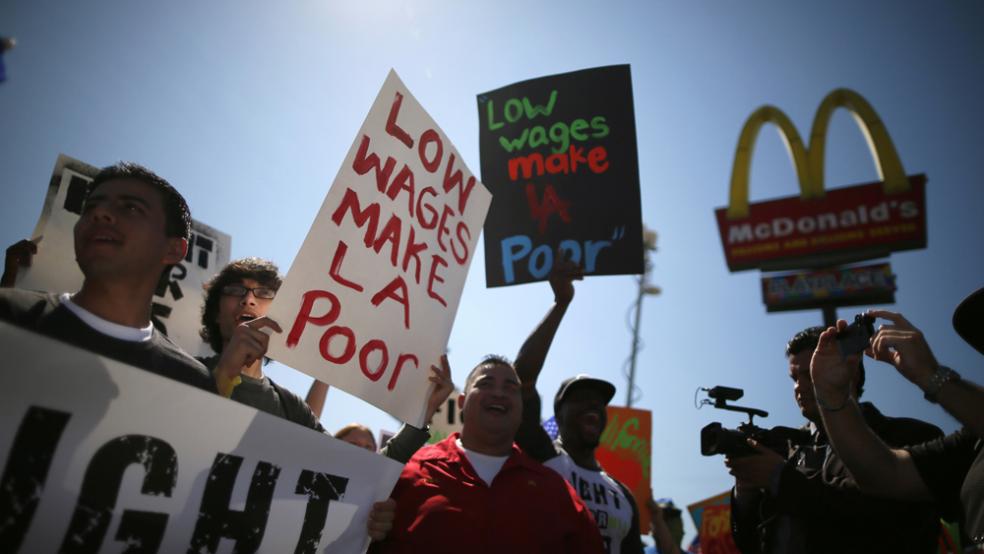California’s legislature this week passed a law that would raise the state’s minimum wage to $10 per hour within three years. The move comes after several months of protests nationwide by retail and fast-food workers demanding higher pay.
The protests have highlighted a long-standing national debate over who and what will raise living standards for the working poor. Steve Odland of the Committee for Economic Development – he’s a former CEO of Office Depot and AutoZone – says that if low-margin companies like retailers and restaurants paid their workers more, company profits and stock prices would drop, undermining value for shareholders and creating problems in other parts of the economy.
And David French of the National Retail Federation argues the focus should be on creating jobs, not raising the minimum wage. “From a macroeconomic standpoint, the best solution for low wages is more jobs and more competition for fewer workers, which will increase wages,” he says. “If you make creating jobs more expensive… employers will create fewer jobs.”
But Paul Sonn of the National Employment Law Project (NELP), which favors increasing the minimum wage, contends history doesn’t bear that out.
RELATED: ARE FAST-FOOD WORKERS RIGHT ABOUT MINIMUM WAGE?
Job creation and profitability at companies that employ low-wage workers have continued to grow even when the minimum wage has increased, he says. A NELP analysis of corporate data last July, showed 75 percent of the largest U.S. employers of minimum or near minimum-wage workers had higher revenues after the recession (either 2012 or 2011, depending on when the company’s fiscal year ended) than before (2007 or 2008). That period also coincided with two minimum wage increases, one in July 2008 and the other in July 2009, to the current $7.25 an hour.
But Sonn wouldn’t specify the level at which the minimum wage would start hurting the availability of jobs. “None of the increases that have been on the table have remotely approached the level that there’s evidence of any harm,” he says. “Whether, theoretically, if you raised the minimum wage to $20 an hour, there would be different impacts – that’s not a question in the real world.”
While those arguments may sound familiar, there are many nuances to the minimum wage debate and plenty of facts that are less well publicized.
Here are six things you don’t know – or forgot – about the minimum wage:
1. The minimum wage’s purchasing power has risen and fallen dramatically over time.
Adjusted for inflation, the minimum wage is more than 80 percent higher than it was when it became law in 1938, according to data from the U.S. Department of Labor. It hit a peak of $10.34 an hour in today’s dollars ($1.60 in real dollars) in 1968. But since then, its purchasing power has fallen 30 percent.
RELATED: RAISE THE MINIMUM WAGE AND GET MINIMUM JOBS
2. The share of workers earning minimum wage has dropped sharply in the past 30 years.
In 1980 and 1981, at the beginning of what was then the worst recession since World War II, the proportion of workers earning minimum wage, or less, hit 15 percent, according to the Bureau of Labor Statistics. Since then, that percentage has fallen to less than 5 percent. (The BLS excludes from its analysis the populations of the 19 states that have minimum wages higher than the federal rate.) There are actually slightly more people making less than minimum wage than making the minimum – the law exempts employees in certain industries, like workers on small farms, fishing operations, or seasonal amusement parks.
3. Modest increases in the minimum wage raise prices, but not much.
The available research indicates that raising the minimum wage increases prices, though modestly. A 2007 study by economists at the Federal Reserve Bank of Chicago and the U.S. Department of Agriculture found that a 21-percent rise in the minimum wage during the late 1990s resulted in price increases at restaurants of .07 percent, or about $.02 on a $30 meal.
And in 2006, two economists, on behalf of the liberal Center for American Progress, analyzed the impact of raising Arizona’s minimum wage by 31 percent, from$5.15 to $6.75 an hour. They projected that to cover the wage increase, a clothing store would need to sell a $20 sweatshirt for $20.02, a restaurant would need to raise a $20 meal to $20.28, and a hotel would need to charge $100.80 for a room instead of $100.
The bigger disagreement among economists is whether the minimum wage affects job availability. A University of Chicago poll of 38 leading economists this February asked whether raising the minimum wage to $9 an hour would make it harder for low-skilled workers to find jobs. The panel split: 34 percent said yes, 32 percent no, and 24 percent were uncertain
4. Those earning minimum wage tend to be young – but a lot of hourly workers aren’t.
Those who object to increasing the minimum wage point out that doing so doesn’t target its benefits to working poor adults – most of those in minimum-wage jobs are young people in transitional jobs. A Heritage Foundation analysis of 2011 and 2012 Census data, for example, concluded that minimum wage workers ages 16−24 came from families with an average income of almost $66,000. (The BLS keeps no statistics on the family incomes of those working at minimum wage.) Still, a lot of older adults also work for the minimum: 49 percent of those at minimum wage are age 25 or older, while 18 percent are 45 or older, according to the BLS. They’re often also primary wage earners for their families: An analysis in March by the Economic Policy Institute, which advocates a minimum-wage increase, calculated that those who would benefit from increasing the federal minimum earned, on average, half of their family’s total income.
5. Blue states don’t necessarily have stronger minimum wage laws.
Of the 27 states that went blue in the 2012 presidential election, 11 don’t have minimum wages above the federal rate. Nineteen states have passed such laws, among those that have not are some Democratic bastions. They include New Jersey, which hasn’t elected a Republican senator in 40 years; Maryland, where 56 percent of registered voters are Democrats; and Hawaii, where Democrats outnumber Republicans in the state Senate and House by 24−1 and 44−7 respectively. And on September 12, the mayor of Democratic stronghold Washington, D.C., vetoed a bill that would have raised the minimum wage for workers at large retailers to $12.50 an hour.
6. Raising the minimum wage will get harder if inflation rises.
Paradoxically, raising the minimum wage might be hardest when inflation is high, since many policymakers believe wage growth puts upward pressure on prices. The inflation of the 1970s affected efforts to raise the minimum wage in those years, says Joseph Minarik of the Committee for Economic Development. Today’s low-inflation economy makes arguments for boosting the federal rate a little easier, he says.





